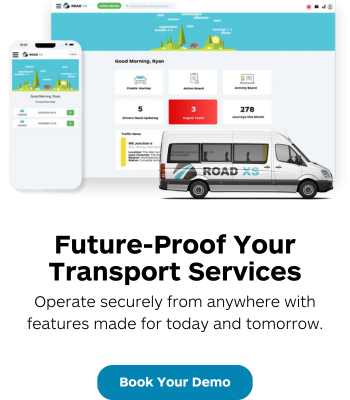In an increasingly fast-paced environment, cost-saving measures are often at the forefront of management decisions. However, when it comes to transport management software, particularly in services for Dial-a-Ride and DRT (Demand Responsive Transport), opting for cheaper, less feature-rich solutions can paradoxically lead to higher costs due to decreased productivity and increased inefficiencies.
In this article, we focus on the community transport service known as Dial a Ride, a form of demand-responsive transport, as a focal point to explore how older transport software lacking real-time optimisation capabilities can result in significant hidden costs, considerably holding back the transport services operations.
The Importance of Real-Time Optimisation in Transport Services
Dial-a-Ride services, which provide transportation for individuals unable to use traditional public transport, require highly efficient routing and scheduling systems.
These services cater to a demographic with specific needs, and any delays or inefficiencies can lead to passenger dissatisfaction and increased operational costs.
Modern transport software uses real-time data and sophisticated algorithms to optimise routes, maximise passenger comfort, manage schedules, and instantly adjust to unforeseen changes, such as traffic conditions, cancellations, or new bookings.
This real-time optimisation is critical in managing the complex variables inherent in transport logistics.
For example, a study by the University of Leeds found that implementing advanced route optimisation technologies can reduce operational costs by 18-35% in transport services like Dial-a-Ride.
This includes considerable savings on fuel consumption, admin time, and vehicle maintenance, significantly improving service efficiency and overall customer satisfaction.
However, many organisations opt for older, less advanced software that relies heavily on manual intervention to reduce costs. Some even use paper or software to work out timings manually, which are, at best, guesstimates.
These “systems” cannot process large amounts of data quickly and accurately, leading to suboptimal routing and scheduling.
The High Cost of Manual Intervention
Older transport management systems typically require human operators to adjust routes and schedules based on static data manually.
This reliance on manual intervention is time-consuming and prone to errors.
A 2019 report by McKinsey & Company found that manual processes in transport management can reduce productivity by up to 30%, as human operators cannot match the speed and accuracy of automated systems.
In the context of Dial-a-Ride services, this inefficiency can manifest in several ways:
- Increased Idle Time: Without real-time optimisation, drivers may spend more time waiting between pickups, leading to higher operational costs.
- Suboptimal Routing: Manually optimised routes may not account for real-time traffic conditions, resulting in longer travel times and increased fuel consumption.
- Increased Administrative Burden: Operators must continuously monitor and adjust schedules, which takes time away from other critical tasks and can potentially lead to burnout. One small change can cause hours of additional manual work.
The Hidden Costs of Inefficiency
Consider the following scenarios:
- Increased Labour Costs: Inefficient routing and scheduling mean drivers may need to work longer hours to complete their routes, leading to increased overtime pay and potential compliance issues with regulations.
- Customer Dissatisfaction: In a Dial-a-Ride service, delays and inefficiencies directly impact customers, leading to complaints and lost service usage through inefficient optimisation. A 2020 study by PwC found that 32% of customers will stop using a service after just one bad experience. Modern apps offer the opportunity to provide real-time updates relating to pickup times and windows with call centres, which then requires fewer passengers who don’t have access to mobile apps.
- Higher Maintenance Costs: Inefficient routes increase vehicle wear and tear, resulting in higher maintenance costs and shorter vehicle lifespans.
- Lower Aggregation: Manually working out routes leads to fewer passengers using the service at any given time, as manually working out routes misses opportunities to optimise the existing passengers better. This can cause passengers to arrive late for appointments, work, or social events.
The Strategic Value of Investing in Advanced Software
Investing in modern, feature-rich transport software may require a higher upfront or monthly cost, but the long-term savings and productivity gains far outweigh this investment.
Advanced software solutions offer:
- Real-Time Data Integration: These systems can pull data from multiple sources, including GPS, traffic feeds, and customer bookings, to make real-time adjustments that optimize routes and schedules.
- Automated Decision-Making: Modern software can automatically make decisions that reduce inefficiencies without human intervention.
- Scalability: As your organisation grows, modern software can scale to accommodate more vehicles, routes, and customers without increasing administrative overhead.
- Improvements Over Time: Modern software will keep learning and improving as your services adapt. This means you get continuous improvements from day one. The longer you use legacy software, the further behind you get each day.
For instance, a case study from Geotab, a leader in transport telematics, showed that organisations using advanced route optimisation software reduced their fleet costs by up to 15% and improved delivery times by 25%.
Building Stronger “On-Demand” Communities
Road XS stands out as the leading software solution for Dial-a-Ride (DaR) and Demand-Responsive Transport (DRT) services, specifically designed to cater to the unique needs of communities. Not only is it approachable to organisations of different sizes, but its modular approach and flexibility make it an all-in-one solution.
Unlike generic transport management systems, Road XS was built with a deep understanding of the complexities of providing accessible and efficient transport for those who need it most.
Whether managing multiple bookings, optimising routes in real-time, or ensuring that each journey is tailored to the individual needs of passengers, Road XS excels in delivering a seamless and reliable service.
What truly sets Road XS apart is its community-focused approach.
The software is not just about moving people from point A to point B; it’s about enhancing the quality of life within communities by providing a dependable and responsive service.
Road XS integrates advanced features like real-time tracking, automated scheduling, and detailed reporting while being user-friendly for operators and passengers. You watch journeys come to life as calculations are handled for you, defined by the rules you set for your services.
By choosing Road XS, organisations can ensure that their Dial-a-Ride and DRT services are efficient and contribute to the well-being and satisfaction of their communities, making it the premier choice for transport solutions built for people.
The False Economy of Cheap Software
Regarding transport software, the adage “you get what you pay for” rings true.
Dial-a-Ride services, which demand high levels of efficiency and customer service, can no longer afford the inefficiencies of outdated software if these services are to remain a viable option to meet increased demand.
While the initial savings of less feature-rich software may seem attractive, the long-term costs—manifested in lost productivity, increased labour, and customer dissatisfaction—can far exceed the price of a more advanced system.
Investing in modern, real-time optimised software is not just a technological upgrade; it is a strategic decision to enhance your organisation’s efficiency, reduce operational costs, and improve passenger satisfaction.
In an industry where time is money and volunteers are becoming a valuable and finite resource, cutting corners on software is a false economy that can cost your organisation much more in the long run.
By recognising the value of advanced transport software, organisations can make informed decisions that drive long-term success and sustainability. They can deliver more journeys for their community with less administrative effort, leading to a more productive transport team and viable service.


